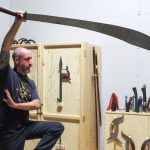Ice is for dead people
At the Montreal Gongfu Research Center, weather in the school or the clinic you will never be advised put ice on yourself.
“Ice is for dead people”, this is the phrase with which our grand Teacher, Hsu Hongchi dismissed the idea of using ice on an injured or painful body part. This has been our standard operating procedure for the past thirty or more years. We never apply ice to ourselves or recommend it to our students and patients.
Of course people have often found it to be strange that we would say this while all of the MDs, Physiotherapists, Sports Chiropractors and what not out there were telling them the opposite.
Many people would also express some relief when they hear our opinion on ice since the idea of icing themselves went against every feeling of common sense that they had and yet they felt conflicted with the advice from their health care professional.
In Chinese medicine cold is a well-defined pathological influence that causes disease in specific ways. One of the most important and foundational books of Chinese medicine titled “Treatise on Cold Damage” was written by Zhan Zhong Jing twelve hundred years ago. We spend a lot of time in clinic treating the effects of cold and educating people about how to better protect themselves from it.
Given this context the idea of purposefully introducing cold into the body makes no sense.
In recent years the accumulated body of research that has developed since icing became popular in the late 1970s has made it clear that at best there is no benefit to icing and it in fact causes damage in various ways. Many well known health care professionals (such as Dr Gabe Mirkin who originally coined the term RICE, see links below) have come forward stating their acknowledgment of previous error and advising against further use of ice.
The idea is slowly taking hold but it seems the majority of health care professionals, coaches, trainers and athletes continue to believe in using ice.
Those that no longer believe in icing now advice protocols which much more closely reflect the way in which traditional Chinese medicine approaches injury management. These protocols are based on movement, compression, elevation, analgesics and treatment.
In our clinics and schools our first line treatment, which absolutely replaces ice for any injury, strain or pain, is external herbal therapy. We have a number of herbal formulas to choose from.
San Huang San-Three Yellows Powder is a widely used classical formula that in recent times has been called “herbal ice”. It is applied as a poultice when there is acute inflammation and dose a beautiful job, reducing swelling and inflammation massively in a matter of hours, or sometime minutes.
Die Da Jiao-Hit Fall Wine is a more elaborate formula of many herbs soaked in liquor to produce a tincture. Many martial artists have their own family recipe handed down through generations.
This can be rubbed into minor aches or strains or formed into a poultice for more serious injuries. The effect of Die Da Jiao is to “Move Qi and Blood” rather than to cool and this movement reduces swelling and promotes healing.
Because of the prevalence of icing injuries we often have to treat chronic pain or stiffness by warming the affected part at the beginning of the treatment because cold from previous icing has become lodged in the tissues. For this we will often use alternative formulas that are warming in nature rather than cooling.
The use of these herbal therapies combined with massage, manipulation, and acupuncture as appropriate provide excellent support in healing and recovery from both acute and chronic injury.
We now find that our gongfu tradition, our personal clinical experiences and modern scientific studies are all in agreement that ice is best for dead people.
Other links on the subjects
http://www.drmirkin.com/fitness/why-ice-delays-recovery.html
http://www.caringmedical.com/sports-injuries/rice-why-we-do-not-recommend-it/
http://www.mobilitywod.com/2012/08/people-weve-got-to-stop-icing-we-were-wrong-sooo-wrong/

